The Influence of Extratropical Weather Regimes on Wintertime Temperature Variations in the Arctic during 1979–2019
Abstract
:1. Introduction
2. Data and Analyses
3. Step-Changes in Sea Ice and Arctic Temperature
4. Characterization of Weather Regimes
5. Wintertime Temperature Variations in the Arctic
6. Summary
Funding
Institutional Review Board Statement
Informed Consent Statement
Data Availability Statement
Acknowledgments
Conflicts of Interest
Appendix
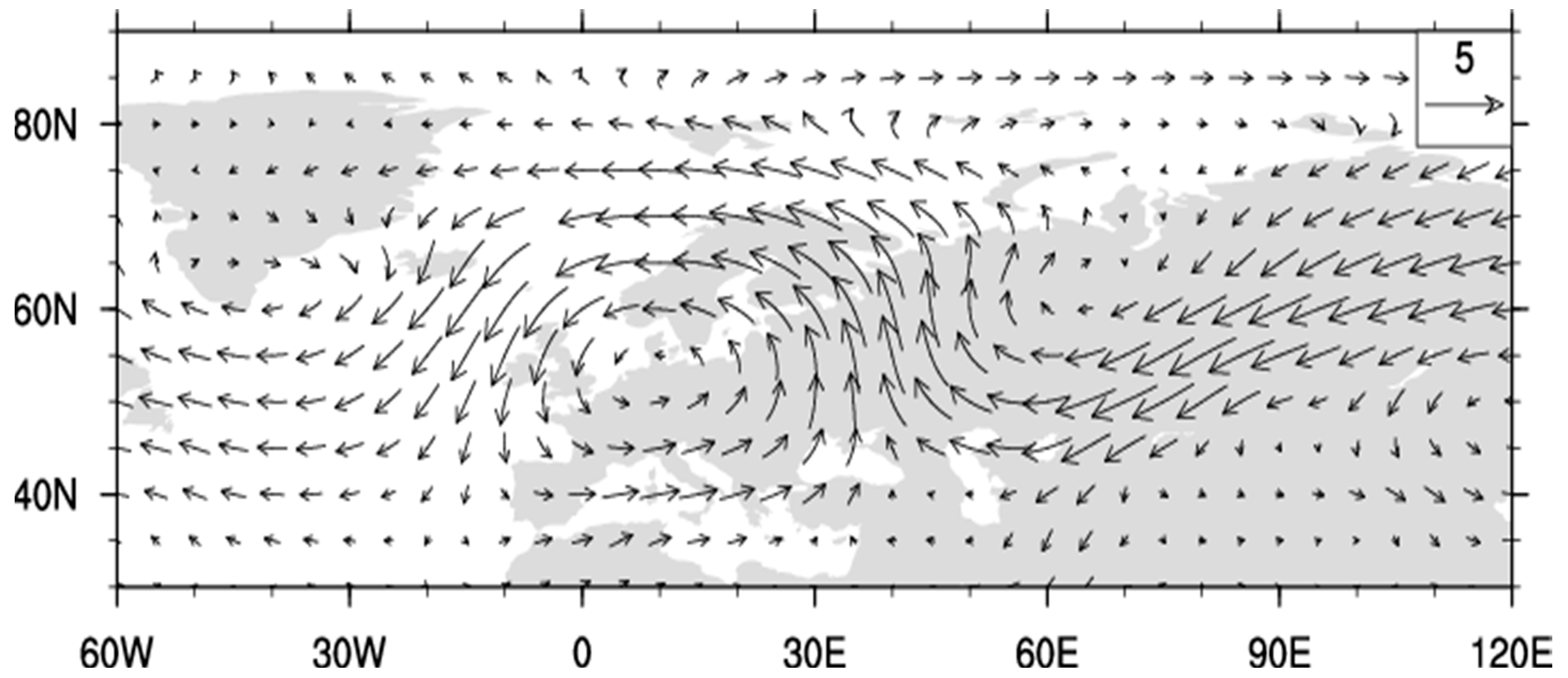

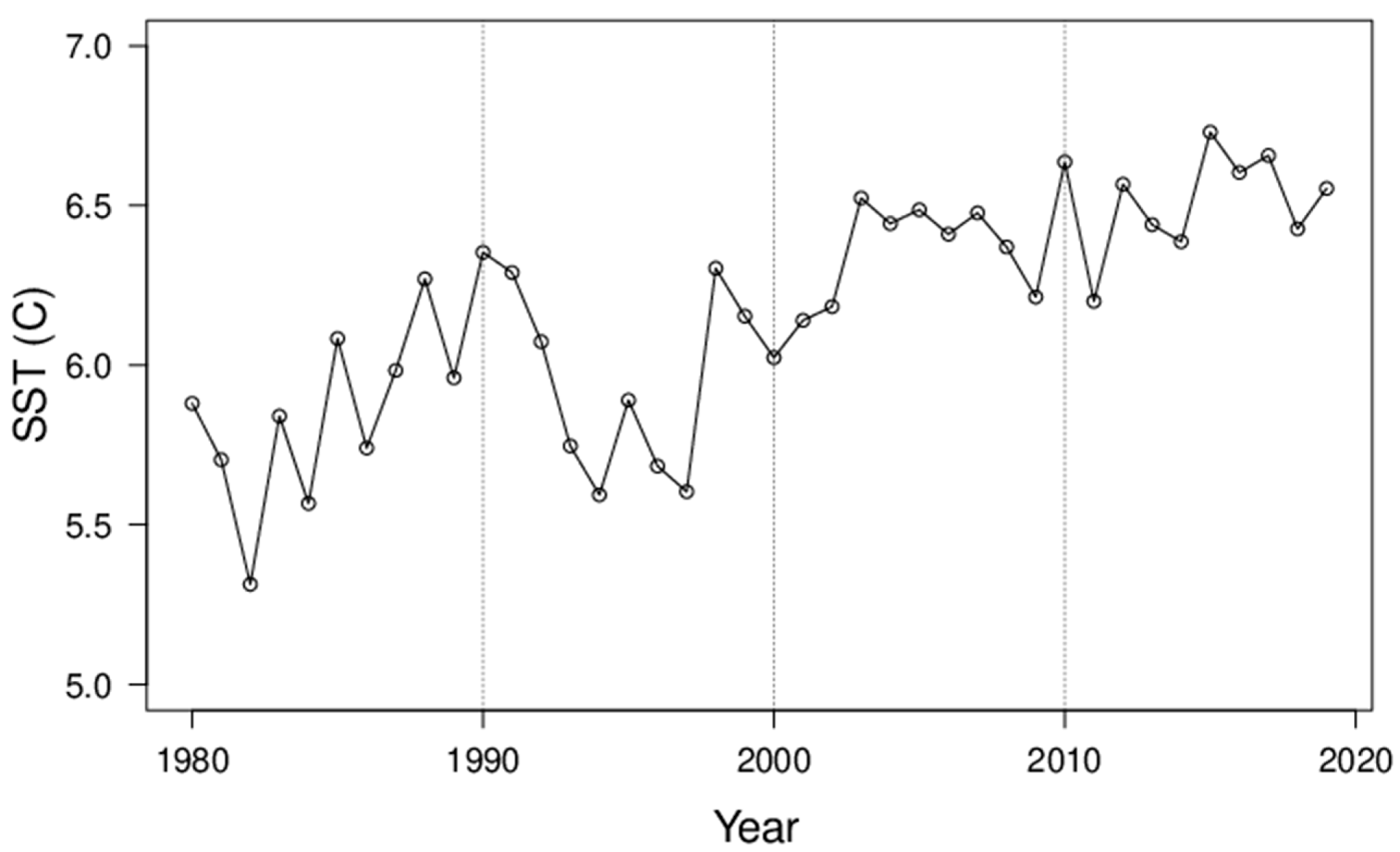
References
- Rheinhold, B.B.; Pierrehumbert, R.T. Dynamics of weather regimes: Quasi-stationary waves and blocking. Mon. Wea. Rev. 1982, 110, 1105–1145. [Google Scholar] [CrossRef] [Green Version]
- Robertson, A.W.; Metz, W. Transient-eddy, feedbacks derived from linear theory and observations. J. Atmos. Sci. 1990, 47, 2743–2764. [Google Scholar] [CrossRef] [Green Version]
- Robertson, A.W.; Ghil, M. Large-scale weather regimes and local climate over the Western United States. J. Clim. 1999, 12, 1796–1813. [Google Scholar] [CrossRef]
- Hannachi, A.; Straus, D.M.; Franzke, C.L.E.; Corti, S.; Woolings, T. Low-frequency nonlinearity and regime behavior in the Northern Hemispshere extratropical atmosphere. Rev. Geophys. 2017, 55, 199–234. [Google Scholar] [CrossRef]
- Wallace, J.M.; Gutzler, D.S. Teleconnections in the potential height field during the Northern Hemisphere winter. Mon. Wea. Rev. 1981, 109, 784–812. [Google Scholar] [CrossRef]
- Blackmon, M.L.; Lee, Y.-H.; Wallace, J.M.; Hsu, H.-H. Time variation of 500 mb height fluctuations with long, intermediate and short time scales as deduced from lag-correlation statistics. J. Atmos. Sci. 1984, 41, 981–991. [Google Scholar] [CrossRef] [Green Version]
- Barnston, A.G.; Livezey, R.E. Classification, seasonality and persistence of low-frequency atmospheric circulation patterns. Mon. Wea. Rev. 1987, 115, 1083–1126. [Google Scholar] [CrossRef]
- Rennert, K.J.; Wallace, J.M. Cross-frequency coupling, skewness, and blocking in the Northern Hemisphere winter circulation. J. Clim. 2009, 22, 5650–5666. [Google Scholar] [CrossRef] [Green Version]
- Roundy, P.E.; MacRitchie, K.; Asuma, J.; Melino, T. Modulation of the global atmospheric circulation by combined activity in the Madden-Julian Oscillation and the El Niño-Southern Oscillation during boreal winter. J. Clim. 2010, 23, 4045–4059. [Google Scholar] [CrossRef] [Green Version]
- Zhang, C. Madden-Julian Oscillation: Bridging weather and climate. Bull. Am. Met. Soc. 2013, 94, 1849–1870. [Google Scholar] [CrossRef]
- Stan, C.; Straus, D.M.; Frederiksen, J.S.; Lin, H.; Maloney, E.D.; Schumacher, C. Review of tropical-extratropical teleconnections on intraseasonal time scales. Rev. Geophys. 2017, 55, 902–937. [Google Scholar] [CrossRef]
- Yuan, X.; Kaplan, M.; Cane, M.A. The interconnected global climate system: A review of tropical-polar teleconnections. J. Clim. 2018, 31, 5765–5792. [Google Scholar] [CrossRef]
- Overland, J.E.; Wang, M. Large-scale atmospheric circulation changes are associated with the recent loss of Arctic sea ice. Tellus 2010, 62, 1–9. [Google Scholar] [CrossRef] [Green Version]
- Mori, M.; Watanabe, M.; Shiogama, H.; Inoue, J.; Kimoto, M. Robust Arctic sea-ice influence on the frequent Eurasian cold winters in past decades. Nat. Geosci. 2014, 7, 869–873. [Google Scholar] [CrossRef]
- Screen, J.A.; Simmonds, I. Increasing fall-winter energy loss from the Arctic Ocean and its role in Arctic temperature amplification. Geophys. Res. Lett. 2010, 37, L16707. [Google Scholar] [CrossRef] [Green Version]
- Screen, J.A.; Simmonds, I.; Deser, C.; Tomas, R. The atmospheric response to three decades of observed Arctic sea ice loss. J. Clim. 2013, 26, 1230–1248. [Google Scholar] [CrossRef] [Green Version]
- Burt, M.A.; Randall, D.A.; Branson, M.D. Dark warming. J. Clim. 2005, 29, 705–719. [Google Scholar] [CrossRef]
- Kim, J.-Y.; Kim, K.-Y. Relative role of horizontal and vertical processes in the physical mechanism of wintertime Arctic amplification. Clim. Dyn. 2019, 52, 6097–6107. [Google Scholar] [CrossRef] [Green Version]
- Cao, Y.; Liang, S.; Chen, X.; He, T.; Wang, D.; Cheng, X. Enhanced wintertime greenhouse effect reinforcing Arctic amplification and initial sea-ice melting. Sci. Rep. 2017, 7, 8462. [Google Scholar] [CrossRef] [Green Version]
- Hankel, C.; Tziperman, E. The role of atmospheric feedbacks in abrupt winter Arctic sea ice loss in future warming scenarios. J. Clim. 2021, 34, 4435–4447. [Google Scholar] [CrossRef]
- Jenkins, M.; Dai, A. The impact of sea-ice loss on Arctic climate feedbacks and their role for Arctic amplification. Geophys. Res. Lett. 2021, 48, e2021GL094599. [Google Scholar] [CrossRef]
- Kalnay, E.; Kanamitsu, M.; Kistler, R.; Collins, W.; Deaven, D.; Gandin, L.; Iredell, M.; Saha, S.; White, G.; Woollen, J.; et al. The NCEP/NCAR 40-Year Reanalysis Project. Bull. Amer. Meteor. Soc. 1996, 77, 437–471. [Google Scholar] [CrossRef] [Green Version]
- Kanamitsu, M.; Ebisuzaki, W.; Woollen, J.; Yang, S.-K.; Hnilo, J.J.; Fiorino, M.; Potter, G.L. NCEP-DOE AMIP-II Reanalysis (R-2). Bull. Amer. Meteor. Soc. 2002, 83, 1631–1643. [Google Scholar] [CrossRef]
- Dee, D.P.; Uppala, S.M.; Simmons, A.J.; Berrisford, P.; Poli, P.; Kobayashi, S.; Andrae, U.; Balmaseda, M.A.; Balsamo, G.; Bauer, D.P.; et al. The ERA-Interim reanalysis: Configuration and performance of the data assimilation system. Quart. J. Roy. Meteor. Soc. 2011, 137, 553–597. [Google Scholar] [CrossRef]
- Meier, W.; Fetterer, F.; Savoie, M.; Mallory, S.; Duerr, R.; Stroeve, J. NAOA/NSIDC Climate Data Record of Passive Microwave Sea Ice Concentration, Version 2; National Snow and Ice Data Center: Boulder, CO, USA, 2013. [Google Scholar] [CrossRef]
- Peng, G.; Meier, W.; Scott, D.; Savoie, M. A long-term and reproducible passive microwave sea ice concentration data record for climate studies and modeling. Earth Syst. Sci. Data 2013, 5, 311–318. [Google Scholar] [CrossRef] [Green Version]
- Bai, J. Least squares estimation of a shift in linear processes. J. Time Ser. Anal. 1994, 15, 453–472. [Google Scholar] [CrossRef] [Green Version]
- Chen, J.; Gupta, A.K. Parametric Statistical Change Point Analysis: With Applications to Genetics, Medicine, and Finance; Springer: Berlin/Heidelberg, Germany, 2012; pp. 212–215. [Google Scholar]
- Zeileis, A.; Kleiber, C.; Krämer, W.; Hornik, K. Testing and dating of structural changes in practice. Comput. Stat. Data Anal. 2003, 44, 109–123. [Google Scholar] [CrossRef] [Green Version]
- Zhang, X.; Lu, C.; Guan, Z. Weakened cyclones, intensified anticyclones and recent extreme cold winter weather events in Eurasia. Environ. Res. Lett. 2012, 7, 044044. [Google Scholar] [CrossRef]
- Feng, C.; Wu, B. Enhancement of Arctic winter warming by the Siberian high over the past decade. Atmos. Ocean. Sci. Lett. 2015, 8, 257–263. [Google Scholar] [CrossRef]
- Sung, M.-K.; Jang, H.-Y.; Kim, B.-M.; Yeh, S.-W.; Choi, Y.-S.; Yoo, C. Tropical influence on the North Pacific Oscillation drives winter extremes in North America. Nat. Clim. Chang. 2019, 9, 413–418. [Google Scholar] [CrossRef]
- Hannachi, A. On the origin of planetary-scale extratropical winter circulation regimes. J. Atmos. Sci. 2010, 67, 1382–1401. [Google Scholar] [CrossRef]
- Woods, C.; Caballero, R.; Svensson, G. Large-scale circulation associated with moisture intrusions into the Arctic during winter. Geophys. Res. Lett. 2013, 40, 4717–4721. [Google Scholar] [CrossRef]
- Luo, D.; Xiao, Y.; Yao, Y.; Dai, A.; Simmonds, I.; Franzke, C. Impact of Ural blocking on winter warm Arctic-cold Eurasian anomalies. Part I: Blocking induced amplification. J. Clim. 2016, 29, 3925–3947. [Google Scholar] [CrossRef]
- Gong, T.; Luo, D. Ural blocking as an amplifier of the Arctic sea ice decline in winter. J. Clim. 2017, 30, 2639–2654. [Google Scholar] [CrossRef]
- Peings, Y. Ural blockings as a driver of early-winter stratospheric warmings. Geophys. Res. Lett. 2019, 46, 5460–5468. [Google Scholar] [CrossRef]
- Cassou, C. Intraseasonal interaction between the Madden-Julian Oscillation and the North Atlantic Oscillation. Nature 2008, 455, 523–527. [Google Scholar] [CrossRef]
- Iversen, T.; Joranger, E. Arctic air pollution and large scale atmospheric flows. Atmos. Environ. 1985, 19, 2099–2108. [Google Scholar] [CrossRef]
- Raatz, W.E. Meteorological conditions over Eurasia and the Arctic contributing to the March 1983 Arctic haze episode. Atmos. Enriron. 1985, 19, 2121–2126. [Google Scholar] [CrossRef]
- Lau, N.-C. Variability of the observed midlatitude storm tracks in relation to low-frequency changes in the circulation pattern. J. Atmos. Sci. 1988, 45, 2718–2743. [Google Scholar] [CrossRef] [Green Version]
- Wu, B.; Wang, J.; Walsh, J.E. Dipole anomaly in the winter Arctic atmosphere and its association with sea ice motion. J. Clim. 2006, 19, 210–225. [Google Scholar] [CrossRef]
- Fan, S.; Yang, X. Arctic and East Asia winter climate variations associated with the eastern Atlantic pattern. J. Clim. 2017, 30, 573–583. [Google Scholar] [CrossRef]
- Lee, S.; Gong, T.; Feldstein, S.B.; Screen, J.A.; Simmonds, I. Revisiting the cause of the 1989–2009 Arctic surface warming using the surface energy budget: Downward infrared radiation dominates the surface fluxes. Geophys. Res. Lett. 2017, 44, 10654–10661. [Google Scholar] [CrossRef]
- Pithan, F.; Mauritsen, T. Arctic amplification dominated by temperature feedbacks in contemporary climate models. Nat. Geosci. 2014, 7, 181–184. [Google Scholar] [CrossRef]
- England, M.R.; Eisenman, I.; Lutsko, N.J.; Wagner, T.J.W. The recent emergence of Arctic Amplification. Geophys. Res. Lett. 2021, 48, e2021GL094086. [Google Scholar] [CrossRef]
- Rayner, N.A.; Parker, D.E.; Horton, E.B.; Folland, C.K.; Alexander, L.V.; Rowell, D.P.; Kent, E.C.; Kaplan, A. Global analysis of sea surface temperature, sea ice, and night marine air temperature since the late nineteenth century. J. Geophys. Res. 2003, 108, D144407. [Google Scholar]
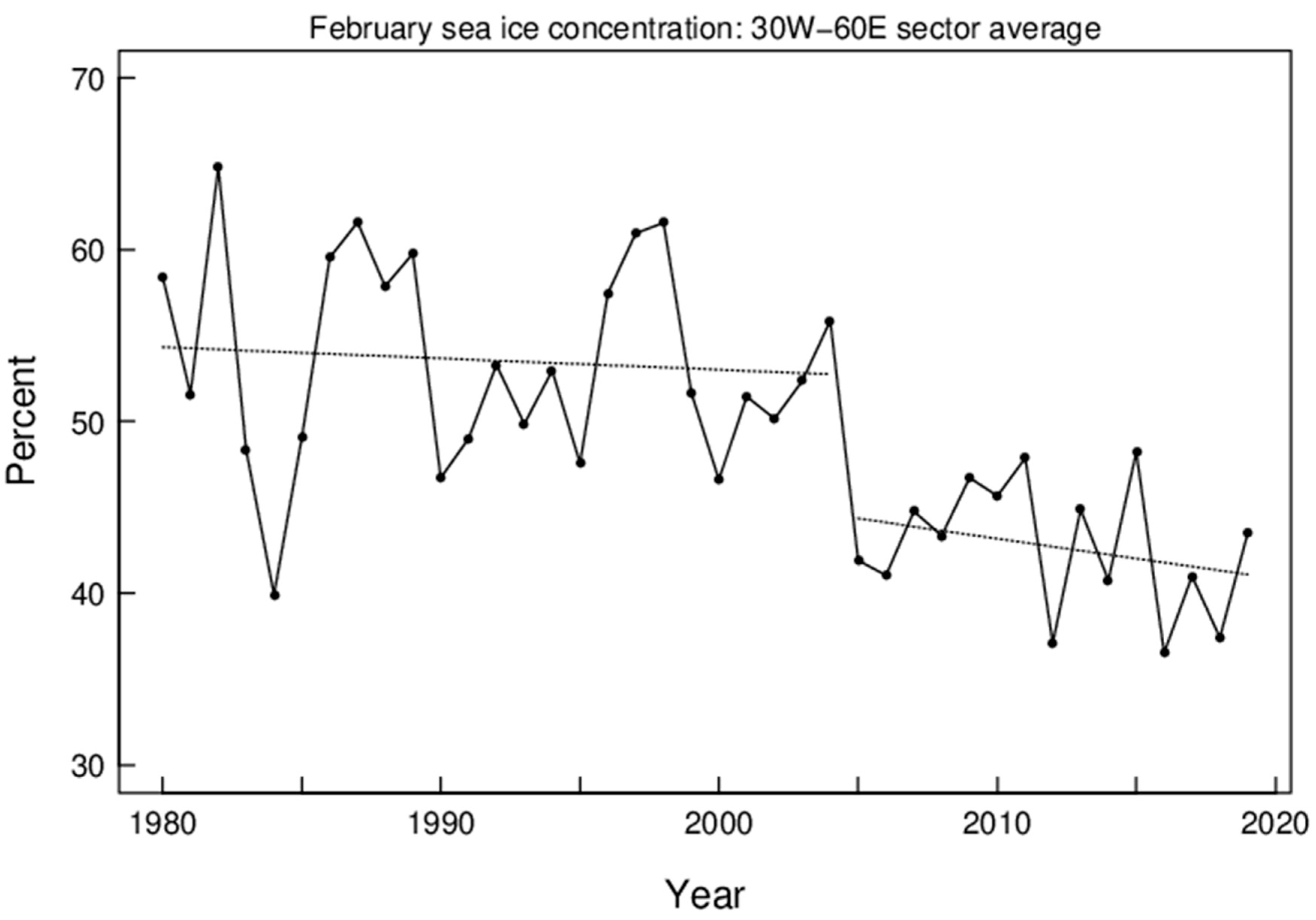
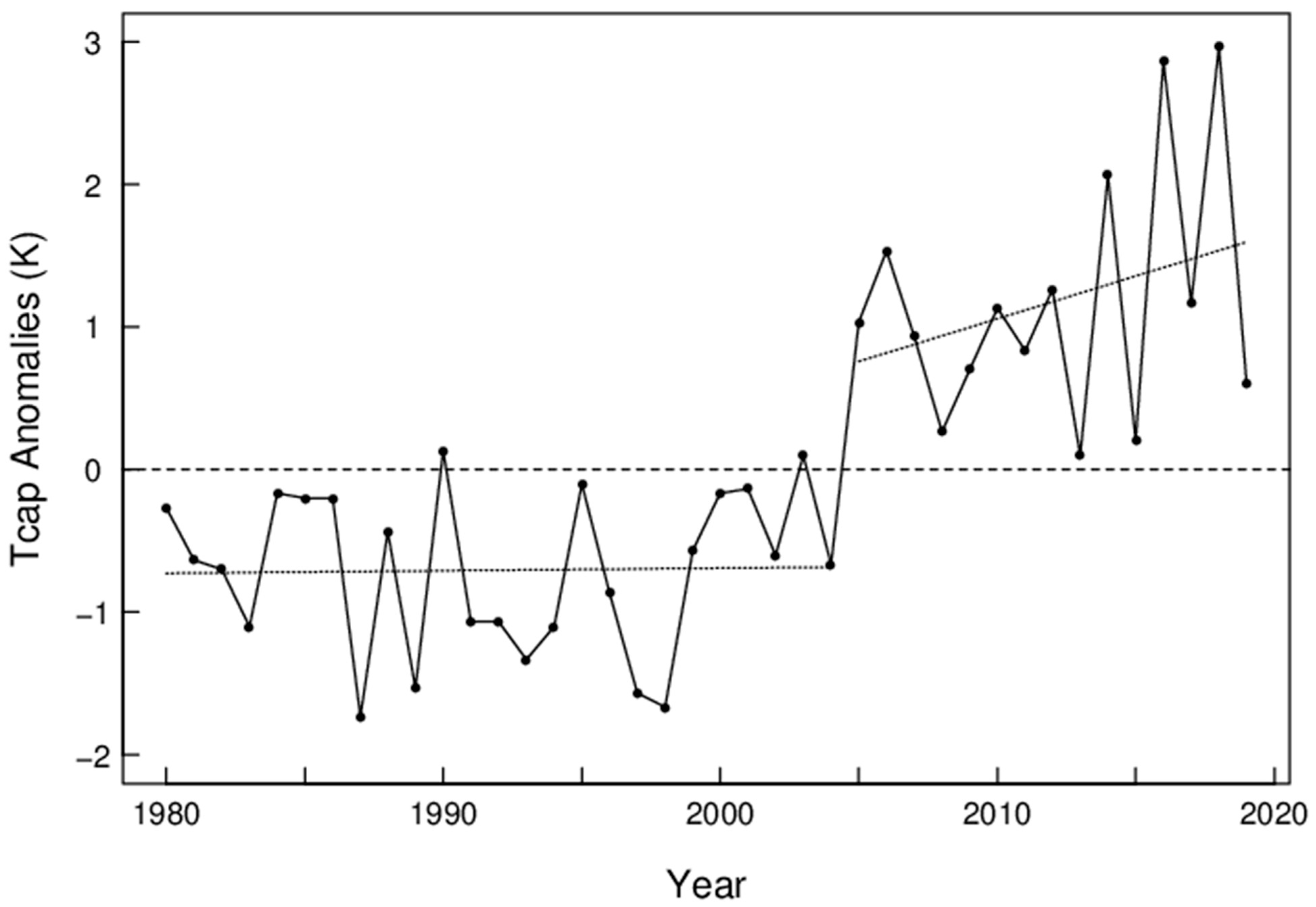


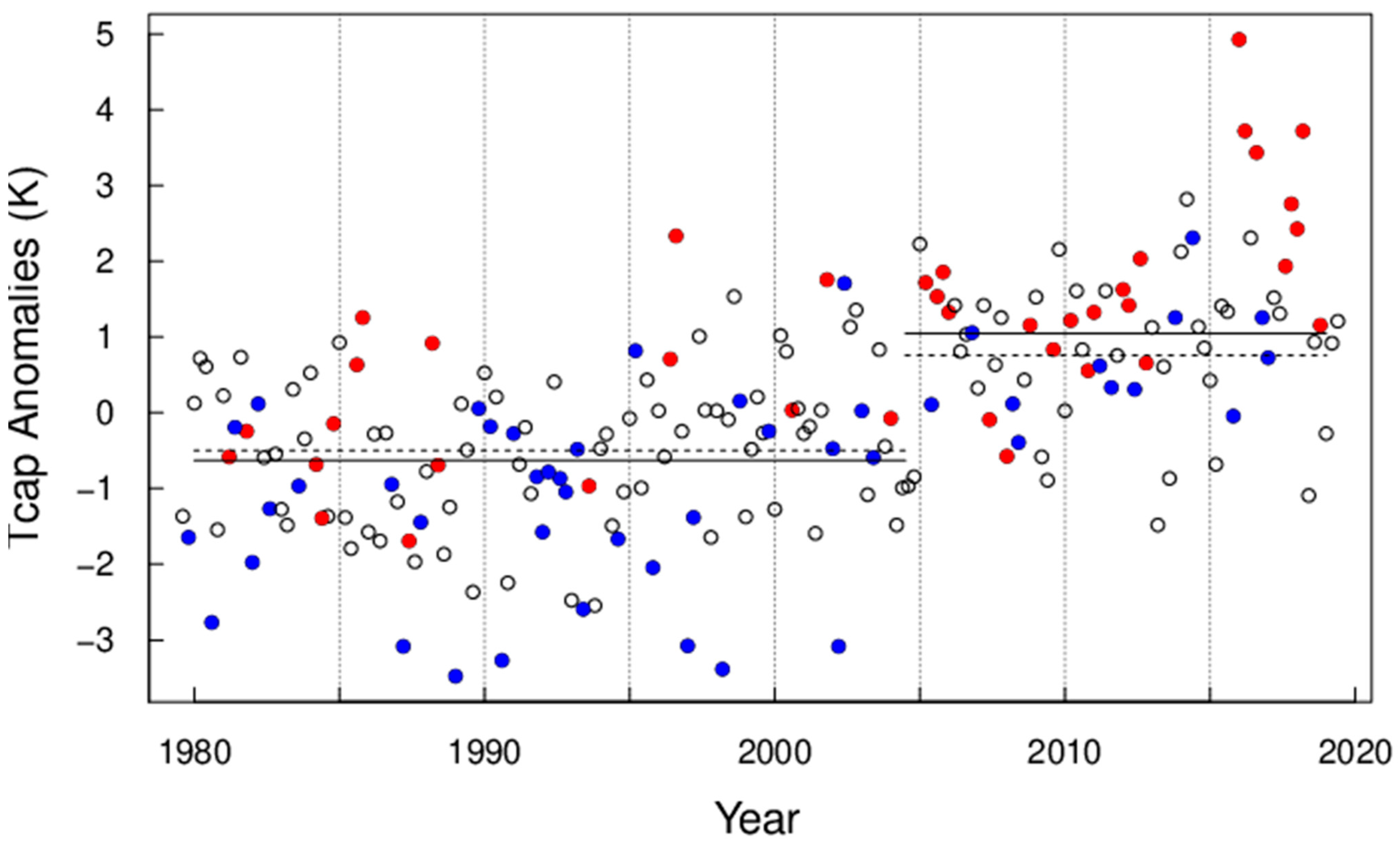
Publisher’s Note: MDPI stays neutral with regard to jurisdictional claims in published maps and institutional affiliations. |
© 2022 by the author. Licensee MDPI, Basel, Switzerland. This article is an open access article distributed under the terms and conditions of the Creative Commons Attribution (CC BY) license (https://creativecommons.org/licenses/by/4.0/).
Share and Cite
Fan, S. The Influence of Extratropical Weather Regimes on Wintertime Temperature Variations in the Arctic during 1979–2019. Atmosphere 2022, 13, 880. https://doi.org/10.3390/atmos13060880
Fan S. The Influence of Extratropical Weather Regimes on Wintertime Temperature Variations in the Arctic during 1979–2019. Atmosphere. 2022; 13(6):880. https://doi.org/10.3390/atmos13060880
Chicago/Turabian StyleFan, Songmiao. 2022. "The Influence of Extratropical Weather Regimes on Wintertime Temperature Variations in the Arctic during 1979–2019" Atmosphere 13, no. 6: 880. https://doi.org/10.3390/atmos13060880
APA StyleFan, S. (2022). The Influence of Extratropical Weather Regimes on Wintertime Temperature Variations in the Arctic during 1979–2019. Atmosphere, 13(6), 880. https://doi.org/10.3390/atmos13060880





